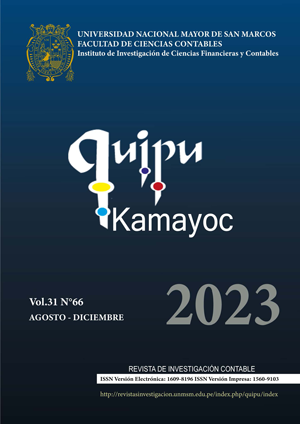Nivel de ventas y sanción de comiso de bienes en los contribuyentes del Perú del sector comercio
DOI:
https://doi.org/10.15381/quipu.v31i66.26225Palabras clave:
tax culture, tax awareness, tax obligation, proof of payment, income declares, confiscation of assetsResumen
Objetivo: Determinar la relación entre el nivel de ventas y la sanción de comiso de bienes de los contribuyentes del sector comercio en Perú durante el periodo 2013-2020. Métodos: El enfoque fue cuantitativo, de nivel relacional, diseño no experimental y naturaleza aplicada. Se realizó una investigación mediante el análisis documental de reportes obtenidos de la Superintendencia Nacional de Aduanas y de Administración Tributaria. Se evaluó la relación entre el nivel de ventas declarado por los contribuyentes y los niveles de sanciones de comiso de bienes efectuados durante el periodo 2013-2020, utilizando la correlación del coeficiente Rho de Spearman. Resultados: Existe una relación inversa y considerable entre los niveles de ventas declarados por los contribuyentes y la sanción de comiso de bienes por no contar con los comprobantes de pago en las intervenciones efectuadas por la Administración Tributaria. Conclusión: A corto plazo, menores niveles de ventas están asociados a una mayor probabilidad de incurrir en la infracción de no portar el comprobante de pago que sustente la propiedad y/o posesión de los bienes transportados por el contribuyente, explicado por una débil cultura tributaria y conciencia de no tributar al fisco.
Descargas
Publicado
Número
Sección
Licencia
Derechos de autor 2023 Irvin Luis Llave Angulo

Esta obra está bajo una licencia internacional Creative Commons Atribución 4.0.
LOS AUTORES RETIENEN SUS DERECHOS:
a. Los autores retienen sus derechos de marca y patente, y también sobre cualquier proceso o procedimiento descrito en el artículo.
b. Los autores retienen el derecho de compartir, copiar, distribuir, ejecutar y comunicar públicamente el articulo publicado en la revista Quipukamayoc (por ejemplo, colocarlo en un repositorio institucional o publicarlo en un libro), con un reconocimiento de su publicación inicial en la revista Quipukamayoc.
c. Los autores retienen el derecho a hacer una posterior publicación de su trabajo, de utilizar el artículo o cualquier parte de aquel (por ejemplo: una compilación de sus trabajos, notas para conferencias, tesis, o para un libro), siempre que indiquen la fuente de publicación (autores del trabajo, revista, volumen, numero y fecha).





























